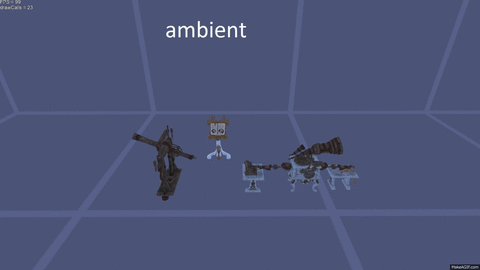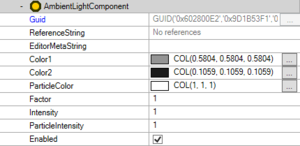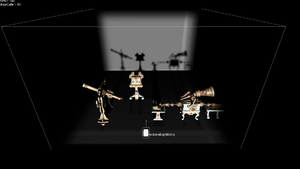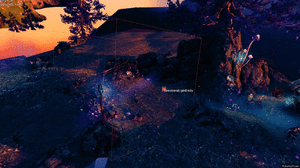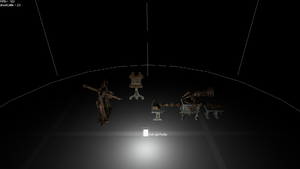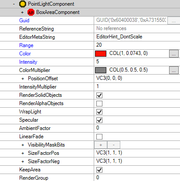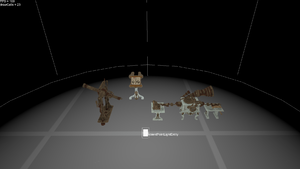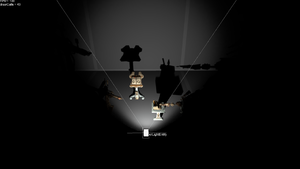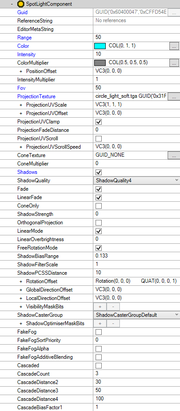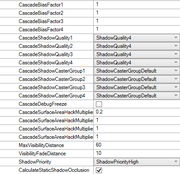Difference between revisions of "LightEntity"
(Created page with "thumb|A gif showing the effects of different types of lights on the scene.|480px This page lists the most important LightEntities found in the edito...") |
(No difference)
|
Latest revision as of 10:13, 15 June 2018
This page lists the most important LightEntities found in the editor and sheds some light (no pun intented) on their usage in Trine 3. There's a lot of general information about lighting in 3d games and related topics in the internet and elsewhere, so the interested reader is encouraged to do some independent searching for more in-depth discussion. Two such resources include the Wikipedia article about shading and a series of blog posts about lighting design theory for 3D games.
Descriptions for the different properties of LightEntities can be found from the editor itself and thus aren't explained here.
Contents
AmbientLightEntity
Ambient lights are used in Trine 3 (and in games in general) to emulate the real world phenomenon of radiative transfer (energy transfer in the form of electromagnetic radiation, e.g. light). After photons are emitted, they are scattered, absorbed and re-emitted multiple times before finally reaching the viewer. This is one of the reasons why in nature there are no completely sharp or black shadows and that it's hard to find a completely dark place during daytime.
AmbientLightEntity is most often used as a global ambient light to set the base tone of the scene. If both color components are identical, as in the gif at the top, they will create the effect of a uniformly lit scene. AmbientLightEntity can also be used as a directional light of sorts, if the Color2 component is a darker shade than Color1 component, as it is by default. This still mimics the behaviour of radiative transfer (absorption, emission, scattering), since AmbientLightEntity can't create shadows.
DirectionalLightEntity
Directional lights are lights that emulate a light source that is infinitely wide and infinitely far, thus "emitting" light rays that are precisely parallel to each other. On Earth, direct sunlight can be approximated as parallel rays of light, and thus directional lights are used in Trine 3 to emulate sunlight and the sharp shadows caused by it. Another common use for directional lighting is a so-called skylight.
On an overcast day when no direct sunlight reaches the ground, objects are still clearly visible and lit. This is due to the light scattering from particles and water droplets in the atmosphere and reaching the ground through the clouds. The same phenomenon causes the sky to look blue during daylight and to be bright and colourful at all. If there was no atmosphere, there would be minimal scattering of light, resulting in a very dark sky and extremely harsh direct sunlight (among other, perhaps more lethal things), although the Sun would appear to be smaller in size. This is the physical phenomenon called "skylight", which is emulated in Trine 3 with a shadowless directional light that is perpendicular to the ground level, i.e. pointing straight down.
Although the effects of skylight and ambient light in the real world are based on the same physical principles (radiative transfer), in Trine 3 they aren't the same thing. Ambient light emulates the light that has already reached the ground and is just "bouncing back and forth" between different objects making everything look more or less the same from any viewing angle, whereas skylight is the diffuse light "coming straight down from the sky", making things look lighter and brighter from above rather than from below.
DirectionalLightEntity is a local directional light which uses an orthographic projection instead of a perspective one. It's local in the sense that it's borders (field of view and range) can be chosen at will so that the light is projected only to a certain area. Most often DirectionalLightEntity is used as a local skylight for the background objects or to create other local but large-scale lighting conditions, like the appearance of a setting sun, as it was used in the beginning of Pontius's tutorial level.
SunDirectionalLightEntity is a global type of DirectionalLightEntity. It's range and field of view don't have any effect on it like they do on local directional lights. Like other directional lights SunDirectionalLightEntity casts orthographic shadows, but unlike any other light in the editor (except for AmbientLightEntity) it's position doesn't determine "where the light is coming from". The direction of the light can be changed only by rotating the SunDirectionalLightEntity, because it's thought to be infinitely far away.
PointLightEntity
Point lights are considered to be minuscule points that radiate isotropic light i.e. light that's the same in all directions. In the real world, only stars other than the Sun are considered point sources of light due to the great distance separating them from Earth. The closest thing to a point light on Earth is a light bulb without a lampshade. Since light bulbs without shades are a quite rare thing to see, point lights aren't a very authentic way to light a scene. The good thing is, they can be used together with other sources of light to create more natural lighting conditions. Point lights are also a very good way to highlight something and to make even small details easy to spot.
PointLightEntity is Trine 3's basic point light. It's color, intensity and range can be chosen to match the desired situation, whether it's large-scale orange-white light coming from bubbling lava or just a tiny speck of light coming from a glowing pink mushroom. PointLightEntity can also be used to cast light on only alpha objects, that is, objects like fog which don't have a solid frame.
PointLightEntity doesn't cast shadows at all.
AmbientPointLightEntity
Ambient lights were discussed above and #AmbientLightEntity was said to be used as a global ambient light to set the tone of the scene. Like local directional lights, there are also local ambient lights. PointLightEntity can be used as a local ambient light by changing the property called AmbientFactor. When this is 0, the PointLightEntity works as a normal point light, but the closer it is to 1, the more it behaves like a local ambient light. This kind of local ambient light works in the same manner as global ambient lights, except it's range can be chosen at will.
SpotLightEntity
Spot lights are like directional lights but the light projection is different. The light is projected in a cone and the shadow projection is perspective instead of ortographic. A flashlight is an example of a spot light. Spotlights are usually used in combination with point lights to create more realistic lighting conditions.
SpotLightEntity is the spot light of Trine 3. It shares many of the properties with DirectionalLightEntity (and SunDirectionalLightEntity), which is somehow explicit, since DirectionalLightComponent is a child type of SpotLightComponent. A SpotLightEntity's range, color, intensity, fov and many other properties can be changed at will to reach the desired lighting conditions. One thing to note is that if there are too many SpotLightEntities with ShadowQuality4 in view at the same time, the shadows will start flickering.
